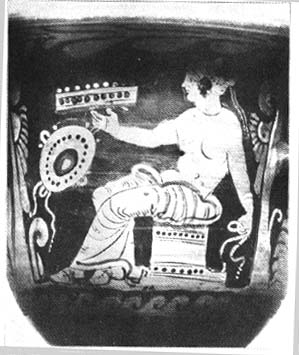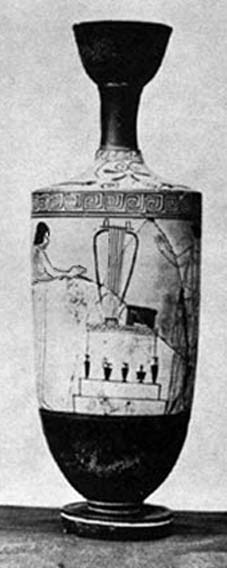Instrumental music in
worship was the power
of the pagan cult of the gods -- the cult of the dead. Roman proverb,
"send for the trumpeters," meant the approach of death. Instrumental
music in worship cannot preach the gospel and it cannot give peace
and comfort to the dead. With that, there is no place for
instrumental music in worship in the land of the living. The general
theme in the lostness of all paganism was:
Let us eat, drink
and be merry for tomorrow we die.
|
The instrumental music in
worship at Mount Sinai was to call the dead Osiris from "across the sea"
to lead Israel.
The music of the
prophesying sons of the prophets from the Philistine high
place was God's sign that "God was dead" to them because
they had "fired" Him.
The musical
instruments in the Monarchy temple was performed over the
dead
animals.
The instrumental
worship "stop the plague" ceremony performed by David and
later by Hezekiah accompanied the death of the people
because of leadership sins.
The music in Job was
to tell God that they were dead to His influence.
The music in Isaiah 5
was the cause and sign that the nation as God's "vineyard"
was dead -- starved because of lack of knowledge.
The "worship" of
Israel condemned by God through Amos was the cult of the
dead.
The harps and music
with which Lucifer came equipped in the agency of the king
of Tyre and of Babylon brought about their death and
Babylon's harps went with them into Sheol.
Jesus had to eject the
professional "team of the dead" before He would raise the
dead.
The "piping" to force
Jesus to dance was to honor the dead Dionysus.
The end-time Babylon
whore religion will be the marriage of commerce and musical
worship -- the the city on seven hills in your own
community.
"Jingling, banging,
and rattling accompanied heathen cults, and the frenzying
shawms of a dozen ecstatic cries intoxicated the masses.
Amid this euphoric farewell feast of a dying civilization,
the voices of nonconformists were emerging from places of
Jewish and early Christian worship ..." (Encyclopedia
Judaica, 1971 ed., s.v. "Music")
|
Israelite worship under the
Monarchy rejected God for a military king to destroy the enemy and
allow them to worship like the nations. Throughout the Old Testament this was instrumental
music in worship in a cult of the dead.
Speaking of the instrumental music in
worship condemned by Amos
and others:
"The
marzeah had an extremely long history extending
at least from the 14th century B.C. through the Roman period. In the
14th century B.C., it was prominently associated with the ancient
Canaanite city of Ugarit (modern Ras Shamra), on the coast of
Syria... The marzeah was a pagan
ritual that took the form of a social and religious association...
Some scholars regard the funerary marzeah as a feast for--and with--deceased ancestors (or Rephaim, a proper name in
the Bible for the inhabitants of Sheol)." (King, Biblical
Archaeological Review, Aug, 1988, p. 35, 35)
"These five elements are: (1)
reclining or relaxing, (2) eating a meat meal, (3) singing with harp
or other musical accompaniment, (4) drinking wine and (5) anointing
oneself with oil." (King, p. 37).
"With the wine-drinking (which
is the literal meaning of the Hebrew for feasting), went music
and dancing." (Heaton, E. W., Everyday Life in Old Testament times,
Scribners, p. 93)
"Worship was form more than
substance; consequently, conduct in the marketplace was totally
unaffected by worship in the holy place. Amos spoke from the
conviction that social
justice is an integral part of the Mosaic
covenant, which regulates relations not only between God and people,
but also among people." (King, p. 44).
"In pagan traditions, musical
instruments are invented by gods or
demi-gods, such as titans.
In the Bible, credit is assigned to antediluvian patriarchs, for
example, the descendants
of Cain in Genesis
4:21. There is no other
biblical tradition
about the invention of
musical instruments." (Freedman, David Noel, Bible Review, Summer
1985, p. 51)
"Slightly less familiar are the
Devil's musical
exploits. He not only
loves singing but is master of the violin, of which instrument of
evil he is reputedly the inventor. By the same token he can give
mastery of the violin, bartering infernal skill for the pupil's soul.
These legends are related to
the larger
belief in the
supernatural origin of
musical skill and
individual songs." (Botkin, B. A., A Treasury of American Folklore,
Crown Publishers, p. 718; Cf. The Devil and the Fiddle, Herbert
Halpert, Hoosier Folklore Bulletin, Vol II (Dec., 1943).
The pagan mind had absolutely no hope in the
resurrection, and the death brought out the people's atheism. The
tombstone of a twenty year old girl, Prokope, reads
"I raise my hands against God, who has taken me away in
my innocence."
Or
"I didn't exist, I was born,
I suffered, I died, I don't exist, I am glad."
The pagan cult of the dead
"with its excessive
manifestation of grief and its instrumental music in worship
extravagance was rejected by the more thoughtful pagans. However, it
was too much a part of the past lives of many Christians, formerly
pagans, for them simply to be able to replace the pagan dirges and
funeral music with psalmody.
To assure people that God was taking care of
the dead, Chrysostom pointed out that Jesus, in performing his miracle, had
cast out (more or less violently) the flute players:
"If the Lord sent
such people away then, so much the more now. Then it was not yet know
that death is merely a sleep; now it is clearer than the sun.... Thus
in the future no one should mourn and lament any longer and bring the
saving work of Christ into discredit... Why not listen to Paul who
says: 'What has Christ to do with Belial?'"
The mystery cults supplied the confidence for
the mourners through music, song, dance and wine: "They offered them
to the dead but ate them for themselves."
Johannes Quasten, in Music and Worship in Pagan and Christian
Antiquity, p. 155
"It is often said that in these portrayals the
relatives of the deceased are depicted coming to the grave to
entertain him with music. But we must first distinguish between the
portrayals in which the dead person has a musical instrument in his
hand and those in which the persons visiting the deceased are
carrying musical instruments.
Among the
Dead: "In the first case the musical
instrument in the dead person's hand -- usually a lyre or tambourine -- is meant to
signify that the deceased no longer leads an
earthly life but is already taken up with the affairs of the other
world." (Note: Job 21; Isaiah 5; Amos 5,6,8 and Ezekiel 33 all show
that the instruments show a disregard for the Words of God)
However, of those still on
Earth (That's us): "The fact remains that the persons
depicted as approaching the deceased on Greek ointment jars
are never playing their instruments... the person
bearing the cithara is stretching out his hands toward the gravestone
on which the dead man is sitting as if he wished to offer the latter
the instrument."
Why? "In antiquity,
singing and instrumental music, playing and dancing were considered
to be the chief occupation and pastime of the blessed... The popular
religions of the time, especially Orphism
and the mystery
cults, portrayed the
life of the blessed as a continual banquet." (ibid. p. 156)
"Originally it was carried out
by relatives and friends who had gathered in the place of mourning,
but later hired
women mourners were employed. The words of lamentation were sung in a
particular mourning tone, and almost everywhere they were sung in
alternation (p. 149)

- The
Cymbal: Painting on a Campanian Mixing bowl. A
deceased person on a gravestone holding a tambourine
(Berlin: Antiquarium)
|

The Lyre:
Oil flask from a Greek cult of
the dead. The lyre is a gift for the deceased (Berlin:
Antiquarium)
|
The harps in revelation was the supernatural
message that as Christians they did not have to engage in pagan
rituals to appease the dead or to make the dead happy: God takes care
of His own. As a result of this message the early church ceased the
musical festivals involved in the cult of the dead:
In Heaven: In Revelation 6:9 John saw the
souls of victorious saints. Souls don't need literal harps made by the hands of men
out of real material. They need "harps from God" or the ability to
sing and speak. When the harps in Revelation are placed in the church
it is a confession of lostness.
Meanwhile Back on the
Earth (where I
live)--Christ wants us to be busy teaching the gospel to everyone in
every nation. That doesn't leave much time for worshiping ourselves
in songs with instruments and dance teams to call God down to the big
meeting:
And I saw another
angel fly in the midst of heaven, having the everlasting gospel to preach unto them
that dwell on the earth, and to every nation, and kindred, and
tongue, and people, Revelation 14:6
Saying with a loud
voice, Fear God, and give glory to him; for the hour of his judgment
is come: and worship him that made heaven, and earth, and the sea,
and the fountains of waters. Revelation 14:7
The harps in Revelation are for
the dead: we cannot preach the everlasting gospel to those on the
other side of the tomb and we cannot do God's work and give peace and
rest to those who have died in the Lord.
Historical Documents and Research on Instrumental
Music as worship
Chronologically
Ordered
-
- Home Page
-
-
-
-

